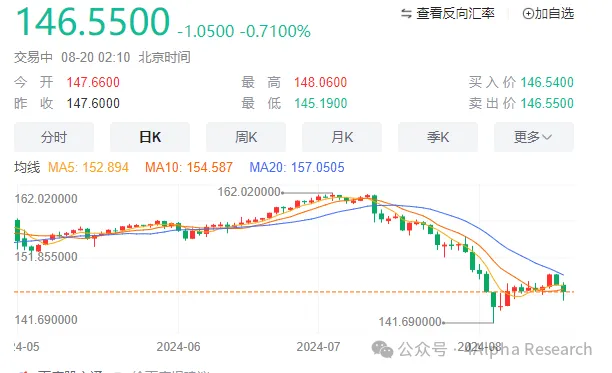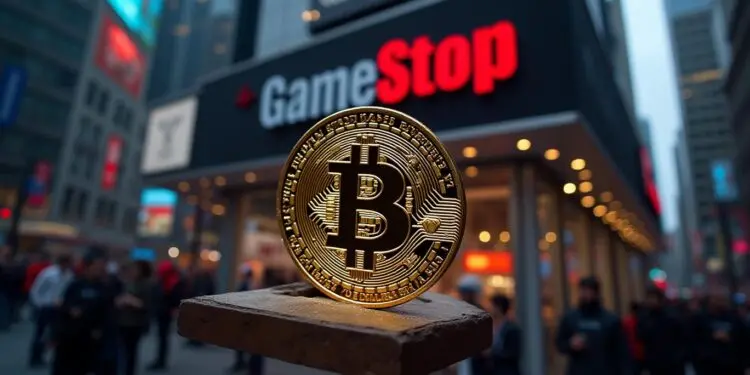The Myth of the Simultaneous Decline of the Dollar, Gold, and Bitcoin: Is it Due to the Yen's Interest Rate Hike and the Reversal of Carry Trades?
4Alpha Research Researcher: Kamiu
Opinions in a nutshell
After the macro big week in July, the dollar, gold, and Bitcoin all fell simultaneously, whereas generally, the probability of these three assets moving in opposite directions is higher.
This is mainly due to the increased margin requirements for yen carry trades, which led to a significant rise in liquidity demand, resulting in a large number of gold and Bitcoin positions being liquidated to provide dollar liquidity.
The recent interest rate hike by the Bank of Japan reflects the Japanese monetary authorities' commitment to maintaining the yen's exchange rate. There is no obvious causal relationship with long-term asset prices, but it may have a more profound impact on Japan's macro economy, significantly affecting Japan's foreign trade and high-end manufacturing recovery.
1. The simultaneous decline of the dollar, gold, and Bitcoin in July is a low-probability event, mainly due to the reversal of yen carry trades leading to temporary liquidity shortages.
Historically, a significant simultaneous decline in gold and Bitcoin priced in dollars is a low-probability event. First, the dollar-denominated prices of both naturally exhibit a negative correlation with the dollar index; when the dollar is strong, gold and Bitcoin tend to appear weaker, thus moving in tandem with fluctuations in the dollar index. Second, both Bitcoin and gold are assets not controlled by sovereign monetary authorities, possessing anti-inflation characteristics and high liquidity, which leads to a general positive correlation in their prices.
As assets negatively correlated with the dollar index, it is generally understood that when the prices or yields of dollar-denominated assets like U.S. Treasuries decline, the prices of gold and Bitcoin should rise due to capital inflows. However, in early August 2024, as a series of important economic data, including the U.S. non-farm payrolls and Q2 CPI, came in far below expectations, the signs of economic slowdown and even recession intensified, and with the Fed's interest rate cut in September almost a foregone conclusion, the dollar index plummeted while gold and Bitcoin prices also saw a significant drop.
We believe this is primarily due to the Bank of Japan's first interest rate hike after announcing the exit from YCC at the end of July, which led to the reversal of yen carry trades. After the economic crisis in Japan in the 1990s, to alleviate the widespread balance sheet issues and bank runs among primary market makers, Japanese monetary policy entered a prolonged low-interest-rate era to combat strong deflationary pressures, widening the interest rate differential between Japan and the U.S. Entering the 21st century, the impact of the 2008 subprime mortgage crisis, coupled with the slow actions of the Bank of Japan, severely impacted the Japanese economy, while an aging population increased pressure on pension and healthcare expenditures, putting fiscal pressure on the government. This ultimately led to the need for more aggressive negative interest rate policies and larger-scale QE actions under Abenomics. Against this backdrop, the interest rate differential between Japan and the U.S. further widened, giving rise to yen carry trades.
Specifically, yen carry trade refers to borrowing yen at extremely low exchange rates and then converting it into dollars to hold dollar-denominated assets. Traders engaging in this arbitrage are colloquially referred to as "Mrs. Watanabe." Under carry trades, one can essentially enjoy a risk-free yield from the long-term interest rate differential between Japan and the U.S., which has been over 3% (and recently up to 5%). Therefore, in recent years, carry trades have become increasingly active, as indicated by the amount of financing by overseas investors in Japan. For instance, Warren Buffett's significant borrowing of yen to purchase Japanese stocks was also due to the relatively low cost of yen-denominated financing among major currencies.
Due to the Bank of Japan's unexpected interest rate hike (policy rate) and the surprisingly hawkish remarks from Governor Kazuo Ueda, Japanese market interest rates, the yen exchange rate, and Japanese bond yields all surged simultaneously, significantly narrowing the interest rate differential between Japan and the U.S. In this context, continuing carry trades became unprofitable, even leading to losses. For many "Mrs. Watanabes" globally, to avoid forced liquidation of positions, they had no choice but to liquidate other safe-haven asset positions (gold, Bitcoin) to convert into dollars for margin calls. This process resulted in a sudden massive sell-off of Bitcoin and gold, leading to the rare phenomenon of simultaneous declines in the dollar index, gold, and Bitcoin.
Thus, the recent plunge in gold and Bitcoin following the yen's interest rate hike is more attributable to incidental factors on the cash flow statement rather than other macroeconomic fluctuations or fundamental reasons in the cryptocurrency market. Currently, the long-end interest rate differential between Japan and the U.S. has fallen below 3%, and as shown in the figure below, the dollar-yen exchange rate has continued to plummet after the rate hike, increasing the cost and difficulty of yen-denominated carry trades, indicating that the retreat of carry trades will continue for some time, which I initially estimate to be around 3-5 months.

2. Historical data shows that apart from Japanese-related assets, the reversal of carry trades does not significantly impact the prices of other assets.
The reversal of carry trades, while leading to a temporary shortage of dollar liquidity and abnormal movements in safe-haven asset prices, will not have much long-term impact on other assets beyond the yen and Japanese bonds, and there is no clear reaction pattern or causal relationship. After the bursting of the bubble economy in the 1990s, when the yen became the main currency for carry trades, there have been five rounds of carry trade reversals historically. Apart from the reversal leading to capital flowing back to Japan, accelerating the yen's appreciation and rising Japanese bond yields, global stock assets have reacted differently to each round of carry trade reversals.
In 1998, 2002, and 2007, although both Japan and the U.S. entered a downward interest rate cycle, the Bank of Japan's rate cuts were not as aggressive as those of the Federal Reserve, leading to a narrowing of the interest rate differential and a reversal of carry trades. In 2015, when the market anticipated the Federal Reserve would halt its rate hike process, and in 2022, when the Bank of Japan raised its YCC and the target yield for ten-year government bonds, although the interest rate differential did not significantly narrow, the market's strong expectations of a decline in the interest rate differential led to a retreat and reversal of carry trades. However, the global stock market's reactions during these five rounds of carry trade fluctuations have not been consistent; for instance, the global stock market performed well in 1998 and 2022, while the other three instances saw poor performance, making it difficult to summarize reliable guiding principles.
3. However, the acceleration of the yen carry trade reversal may have profound implications for Japan's macro economy.
The relationship between the yen exchange rate and the reversal of carry trades presents a web-like cyclical logic chain. Central bank interest rate hikes lead to a narrowing of interest rate differentials and a reversal of carry trades, which in turn leads to capital inflows and yen appreciation. The expansion of returns on yen-denominated assets further weakens the motivation for carry trades, creating a reinforcing cycle. Faced with the sharp decline of the yen this year, the Bank of Japan has resolutely implemented interest rate hikes to maintain the stability of the purchasing power of its currency, clearly supporting the yen's exchange rate. This is understandable, but in light of the long-standing issue of yen appreciation harming the Japanese economy, the Japanese authorities do not seem to have provided a good solution.
Here, this article aims to explore a frequently mentioned "paradox": the proportion of Japan's foreign trade economy in GDP does not seem that large, so why is there always an emphasis on the impact of exchange rates on Japan's foreign trade and the notion that Japan is an export-oriented economy?
The reason lies in Japan's exports, which are primarily industrial products, with automobiles being the absolute mainstay. The automotive industry, especially the fuel vehicle sector, has a long supply chain, providing a large number of direct employment opportunities in the secondary industry (upstream parts factories, etc.) and supporting jobs in the tertiary industry (services for industrial workers in industrial clusters). Moreover, Japan's automotive manufacturing efficiency is evidently more advanced compared to other service industries and non-trade sectors. Due to the existence of the Balassa-Samuelson effect (as shown in the figure below), the high wage levels in the manufacturing trade sector quickly transmit to the non-trade sector, driving the overall development of the Japanese economy, and this effect is far greater than what is reflected by the narrow definition of the foreign trade GDP proportion. Additionally, major Japanese automotive brands like Toyota and Honda have established numerous factories overseas to sell directly in local markets (such as domestic joint venture vehicles), which do not count towards GDP, leading to an underestimation of the export sector's pillar role in the Japanese economy.

Therefore, under the premise of continued weak domestic demand in Japan, a significant appreciation of the yen is not good news for the Japanese automotive industry, which is struggling globally against Chinese automotive competition, and for the Japanese semiconductor industry, which is trying to regain its former glory. Over the past 30 years, Japan's economy and policy authorities have been fighting fiercely against deflation; even without implementing any tightening policies, just being slightly slower than the Federal Reserve's easing measures can lead to significant economic weakness. The Bank of Japan's recent clear hawkish stance after many years undoubtedly casts a shadow over the short-term future of Japan's economy.










